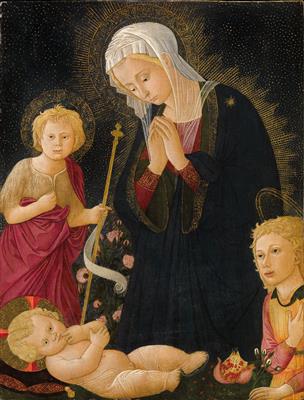Pseudo Pier Francesco Fiorentino

(active in the last quarter of the 15th century)
Madonna and Child with the Infant Saint John the Baptist and an Angel,
tempera and gold on canvas laid down on panel, 72 x 53 cm, framed
Provenance:
G. Orlandi collection, Rome (1961);
European Private Collection
We are grateful to Professor Alessandro Tomei for confirming the attribution of the present painting on the basis of a photograph.
The present painting is a characteristic work by the so-called Pseudo Pier Francesco Fiorentino or the Lippi-Pesellino Imitators.
In 1928, Frederick Mason Perkins was the first to suggest differentiating between Pier Francesco Fiorentino (Florence 1444 or 1445 – after 1497) and Pseudo Pier Francesco Fiorentino. To this latter artist he assigned a substantial number of works that Bernard Berenson had attributed to the ‘true’ Pier Francesco Fiorentino, a student of Benozzo Gozzoli and Neri di Bicci, in 1900 (F. M. Perkins, Nuovi appunti sulla Galleria Belle Arti di Siena, in: La Balzana, n.s., II, 1928, pp. 183–203, p. 189). Subsequently the differentiation between those two artists was also accepted by Berenson. In 1958, Federico Zeri was the first to regard Pseudo Pier Francesco no longer as an individual artist, but – not least because of the comprehensive oeuvre in question – as a group of artists or workshop, which he named the “Lippi-Pesellino Imitators”. With the aid of cartoons, works were produced and partly combined compositions by Fra Filippo Lippi and Francesco Pesellino. The works of this group of artists are characterised by a generous application of gold leaf, and many of them show a hedge of roses in the background.
As to the posture of the Madonna and Child, the present painting clearly betrays borrowings from Filippo Lippi, namely from his Adoration of the Child and Saint Bernard (now in the Gemäldegalerie, Berlin). The figures of the Madonna, the Christ Child, and the young Saint John the Baptist appear to have virtually been cut out from that painting, the angel derives from Pesellino’s Madonna and Child with Angels in the Toledo Museum of Art, Toledo. In keeping with the seemingly accumulative personality of the artist, several symbolically significant objects have been included in the iconography. The pomegranate on the ledge points to the Resurrection. The flowers also play an iconographical role: the roses are the attributes of Her love. However, the present painting differs considerably in the background, which seems simplified, with several roses discernable between the Madonna and the Baptist. The figure of the angel on the right-hand side is known form other works attributed to the same group of artists. A similar composition is preserved in the Széptmüvészeti Múzeum in Budapest.
09.04.2014 - 18:00
- Dosažená cena: **
-
EUR 110.100,-
- Odhadní cena:
-
EUR 80.000,- do EUR 120.000,-
Pseudo Pier Francesco Fiorentino
(active in the last quarter of the 15th century)
Madonna and Child with the Infant Saint John the Baptist and an Angel,
tempera and gold on canvas laid down on panel, 72 x 53 cm, framed
Provenance:
G. Orlandi collection, Rome (1961);
European Private Collection
We are grateful to Professor Alessandro Tomei for confirming the attribution of the present painting on the basis of a photograph.
The present painting is a characteristic work by the so-called Pseudo Pier Francesco Fiorentino or the Lippi-Pesellino Imitators.
In 1928, Frederick Mason Perkins was the first to suggest differentiating between Pier Francesco Fiorentino (Florence 1444 or 1445 – after 1497) and Pseudo Pier Francesco Fiorentino. To this latter artist he assigned a substantial number of works that Bernard Berenson had attributed to the ‘true’ Pier Francesco Fiorentino, a student of Benozzo Gozzoli and Neri di Bicci, in 1900 (F. M. Perkins, Nuovi appunti sulla Galleria Belle Arti di Siena, in: La Balzana, n.s., II, 1928, pp. 183–203, p. 189). Subsequently the differentiation between those two artists was also accepted by Berenson. In 1958, Federico Zeri was the first to regard Pseudo Pier Francesco no longer as an individual artist, but – not least because of the comprehensive oeuvre in question – as a group of artists or workshop, which he named the “Lippi-Pesellino Imitators”. With the aid of cartoons, works were produced and partly combined compositions by Fra Filippo Lippi and Francesco Pesellino. The works of this group of artists are characterised by a generous application of gold leaf, and many of them show a hedge of roses in the background.
As to the posture of the Madonna and Child, the present painting clearly betrays borrowings from Filippo Lippi, namely from his Adoration of the Child and Saint Bernard (now in the Gemäldegalerie, Berlin). The figures of the Madonna, the Christ Child, and the young Saint John the Baptist appear to have virtually been cut out from that painting, the angel derives from Pesellino’s Madonna and Child with Angels in the Toledo Museum of Art, Toledo. In keeping with the seemingly accumulative personality of the artist, several symbolically significant objects have been included in the iconography. The pomegranate on the ledge points to the Resurrection. The flowers also play an iconographical role: the roses are the attributes of Her love. However, the present painting differs considerably in the background, which seems simplified, with several roses discernable between the Madonna and the Baptist. The figure of the angel on the right-hand side is known form other works attributed to the same group of artists. A similar composition is preserved in the Széptmüvészeti Múzeum in Budapest.
|
Horká linka kupujících
Po-Pá: 10.00 - 17.00
old.masters@dorotheum.at +43 1 515 60 403 |
| Aukce: | Obrazy starých mistr? |
| Typ aukce: | Salónní aukce |
| Datum: | 09.04.2014 - 18:00 |
| Místo konání aukce: | Wien | Palais Dorotheum |
| Prohlídka: | 29.03. - 09.04.2014 |
** Kupní cena vč. poplatku kupujícího a DPH
Není již možné podávat příkazy ke koupi přes internet. Aukce se právě připravuje resp. byla již uskutečněna.
Všechny objekty umělce
